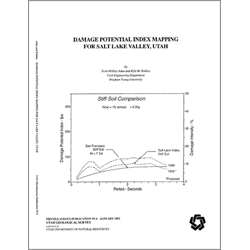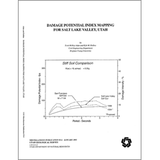Damage potential index mapping for Salt Lake Valley, Utah (MP 93-4)
By: S. M. Adan and K. M. Rollins
The fact that local soil conditions play a major role in determining the intensity of earthquake shaking has been recognized by seismologists and engineers for many years. Recently, a number of major earthquakes have provided excellent opportunities to study the relationship between local soil conditions, earthquake shaking intensities, and building damage. During these earthquakes, substantial differences in recorded maximum accelerations were observed at soil sites in relation to rock sites.
The potential for soil amplification of lacustrine deposits in the Salt Lake Valley has been recognized for some time based on low-amplitude ground motions measured after nuclear detonations at the Nevada test site. Spectral amplification ratios (spectral acceleration on soil divided by spectral acceleration on rock) recorded by U.S. Geological Survey researchers following these detonations are between 5 to 10 in large areas of the valley
The purpose of this study is to examine the possibility of soil amplification in selected areas of the Salt Lake Valley, estimate expected ground motion characteristics, and provide an evaluation of the damage potential index for these areas. Based on research performed by Seed and Sun (1989) following the 1985 Mexico City earthquake, we will then relate these index values to expected damage intensities. Finally, we will comment on recommendations regarding possible code revisions to reduce potential earthquake damage.
Other Information:
Published: 1993
Pages: 64 p.
Location: Salt Lake County
Media Type: Paper Publication







